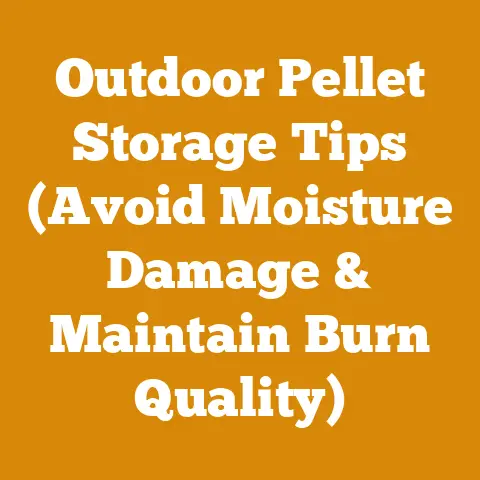Royall Wood Furnace Tips (Indoor Setup & Efficiency Hacks)
Let’s face it, when most people think about wood furnaces, they picture a smoky, inefficient contraption relegated to a drafty corner of the basement. They imagine constant stoking, uneven heat, and a never-ending battle against creosote buildup. But that’s a misconception I’m here to challenge, especially when we’re talking about Royall wood furnaces. With the right setup and efficiency hacks, a Royall can be a clean-burning, cost-effective, and reliable heating source for your home. As someone who’s spent years wrestling with wood, from felling trees in the biting winter wind to meticulously stacking cords for optimal seasoning, I’ve learned firsthand what it takes to unlock the true potential of wood-fired heating.
Understanding Your Royall Wood Furnace: A Foundation for Efficiency
Before we get into the nitty-gritty of setups and hacks, it’s crucial to understand the fundamentals of how your Royall wood furnace works. These aren’t just metal boxes that burn wood; they’re carefully engineered systems designed to extract the most heat possible from a renewable resource.
The Combustion Process: Where Efficiency Begins
The heart of any wood furnace is the combustion chamber, where the magic (or sometimes the frustration) happens. Efficient combustion relies on three key elements:
- Heat: Enough heat to ignite the wood and sustain the burning process.
- Oxygen: An adequate supply of oxygen to fuel the fire.
- Fuel: Dry, seasoned wood that releases its energy efficiently.
When these three elements are in balance, you achieve complete combustion, which translates to more heat, less smoke, and reduced creosote buildup. Incomplete combustion, on the other hand, wastes fuel, pollutes the air, and creates a dangerous fire hazard.
Royall’s Design: Key Features for Enhanced Performance
Royall wood furnaces are known for their robust construction and thoughtful design features that contribute to their efficiency. Here are a few key aspects to consider:
- Firebox Size and Design: The size of the firebox dictates how much wood you can load at once, influencing burn time and heat output. The design, including the shape and placement of air inlets, affects airflow patterns and combustion efficiency.
- Heat Exchanger: This critical component transfers the heat from the combustion gases to the air or water that circulates through your home. A well-designed heat exchanger maximizes heat transfer and minimizes heat loss up the chimney.
- Draft Control: Proper draft is essential for efficient combustion. Royall furnaces typically have adjustable dampers or barometric draft controls that allow you to regulate the airflow through the furnace.
- Secondary Combustion: Some Royall models incorporate secondary combustion chambers, where unburned gases from the primary firebox are ignited, further increasing efficiency and reducing emissions.
Data Point: The Impact of Complete Combustion
According to the EPA, a well-tuned wood furnace with complete combustion can achieve efficiencies of 70-80%, while an inefficient furnace with incomplete combustion may only reach 40-50%. That’s a significant difference that directly impacts your wood consumption and heating costs.
Indoor Setup: Optimizing Placement and Ventilation
The location of your Royall wood furnace within your home is just as crucial as the furnace itself. A poorly planned installation can lead to uneven heating, safety hazards, and reduced efficiency.
Location, Location, Location: Choosing the Right Spot
When selecting a location for your Royall wood furnace, consider the following factors:
- Clearance to Combustibles: This is paramount for safety. Follow the manufacturer’s guidelines for minimum clearances to walls, ceilings, and other combustible materials. A general rule of thumb is at least 36 inches on all sides, but always consult your furnace’s manual for specific requirements.
- Proximity to Chimney: A shorter, straighter chimney run is generally more efficient and less prone to creosote buildup. Ideally, the furnace should be located as close as possible to the chimney.
- Air Circulation: The furnace should be placed in an area where it can effectively circulate heated air throughout your home. Consider the layout of your ductwork and the natural airflow patterns in your house.
- Accessibility: You’ll need easy access to the furnace for loading wood, cleaning, and maintenance. Make sure there’s enough space to maneuver around the unit comfortably.
- Floor Support: Wood furnaces are heavy. Ensure the floor can support the weight of the furnace, especially when fully loaded with wood. If necessary, reinforce the floor with additional supports.
Ventilation: Ensuring Adequate Air Supply
Wood furnaces require a constant supply of fresh air for combustion. Inadequate ventilation can lead to:
- Backdrafting: Smoke and carbon monoxide can be drawn back into your home.
- Inefficient Combustion: The fire will struggle to burn properly, wasting fuel.
- Negative Pressure: The furnace can depressurize your home, drawing in cold air from outside.
To ensure adequate ventilation, consider the following:
- Dedicated Air Intake: Install a dedicated air intake duct that draws fresh air from outside. This is particularly important in tightly sealed homes.
- Combustion Air Openings: Ensure that any existing combustion air openings are not blocked or obstructed.
- Relief Valves: Install relief valves in the ductwork to prevent excessive pressure buildup.
Story Time: My Close Call with Backdrafting
I once installed a wood stove in a cabin without properly accounting for ventilation. On a particularly cold night, the stove began to backdraft, filling the cabin with smoke. Luckily, I caught it early and was able to open windows and doors to clear the air. It was a scary reminder of the importance of proper ventilation.
Data Point: Ventilation Requirements
The National Fire Protection Association (NFPA) recommends a minimum of 1 square inch of free area for every 1,000 BTU/hr of appliance input. For example, a 100,000 BTU/hr wood furnace would require at least 100 square inches of free area for combustion air.
Fueling Efficiency: Wood Selection, Seasoning, and Storage
The type and quality of wood you burn have a significant impact on your Royall wood furnace’s efficiency. Burning unseasoned wood is like trying to run a car on water – it simply won’t work well.
Hardwood vs. Softwood: Understanding the Differences
- Hardwoods: Generally denser and contain more energy per unit volume than softwoods. They burn longer and produce more heat. Examples include oak, maple, ash, and beech.
- Softwoods: Burn faster and produce less heat. They also tend to create more smoke and creosote. Examples include pine, fir, spruce, and cedar.
While hardwoods are generally preferred for wood furnaces, softwoods can be used effectively if properly seasoned and burned in a controlled manner. I often mix softwoods with hardwoods to get a fire started quickly.
The Science of Seasoning: Drying Wood for Optimal Combustion
Seasoning is the process of drying wood to reduce its moisture content. Freshly cut wood can contain as much as 50% moisture, while properly seasoned wood should have a moisture content of 20% or less.
Here’s why seasoning is so important:
- Increased Heat Output: Dry wood burns hotter and more efficiently than wet wood.
- Reduced Smoke and Creosote: Wet wood produces excessive smoke and creosote, which can clog your chimney and pose a fire hazard.
- Easier Ignition: Dry wood lights more easily and burns more consistently.
Seasoning Techniques: The Art of Patient Waiting
The key to successful seasoning is to allow the wood to dry naturally over time. Here are some proven techniques:
- Splitting: Splitting the wood exposes more surface area, accelerating the drying process.
- Stacking: Stack the wood in a single row, off the ground, with good air circulation.
- Location: Choose a sunny, windy location for your woodpile.
- Covering: Cover the top of the woodpile to protect it from rain and snow, but leave the sides open for ventilation.
Data Point: Moisture Content and Heat Output
According to the U.S. Forest Service, burning wood with a moisture content of 20% or less can increase heat output by as much as 50% compared to burning green wood.
Storage Strategies: Protecting Your Investment
Once your wood is properly seasoned, it’s important to store it in a dry, protected location. Here are some storage tips:
- Elevated Storage: Store the wood on pallets or a raised platform to prevent ground moisture from seeping into the wood.
- Covered Storage: A woodshed or tarp can protect the wood from rain and snow.
- Ventilation: Ensure adequate ventilation to prevent moisture buildup inside the storage area.
- Pest Control: Take measures to prevent insect infestations and rodent damage.
My Wood Seasoning Experiment
I once conducted an experiment where I seasoned two identical piles of wood, one covered and one uncovered. After a year, the covered pile had a moisture content of 15%, while the uncovered pile had a moisture content of 25%. This simple experiment demonstrated the effectiveness of covering wood during seasoning.
Optimizing Airflow: The Key to Efficient Combustion
Airflow is the lifeblood of your Royall wood furnace. Proper airflow ensures complete combustion, maximizes heat output, and minimizes smoke and creosote.
Understanding Draft: The Force Behind the Fire
Draft is the difference in pressure between the inside of the chimney and the outside air. This pressure difference creates a natural flow of air up the chimney, drawing combustion gases out of the furnace and pulling fresh air into the firebox.
Factors that affect draft include:
- Chimney Height: Taller chimneys generally produce stronger draft.
- Chimney Diameter: The chimney diameter should be properly sized for the furnace.
- Chimney Temperature: Warm chimneys produce stronger draft than cold chimneys.
- Weather Conditions: Wind and temperature fluctuations can affect draft.
Controlling Draft: Dampers and Barometric Draft Controls
Royall wood furnaces typically have adjustable dampers or barometric draft controls that allow you to regulate the airflow through the furnace.
- Dampers: Simple metal plates that can be opened or closed to restrict airflow.
- Barometric Draft Controls: Automatically adjust the draft based on changes in atmospheric pressure.
Properly adjusting the draft is crucial for efficient combustion. Too much draft can cause the fire to burn too quickly, wasting fuel. Too little draft can lead to incomplete combustion and excessive smoke.
Air Inlet Adjustments: Fine-Tuning Combustion
In addition to draft controls, Royall furnaces often have adjustable air inlets that allow you to fine-tune the combustion process. These inlets control the amount of air that enters the firebox, influencing the intensity and efficiency of the fire.
Experiment with different air inlet settings to find the optimal balance for your specific wood type and burning conditions.
Case Study: Optimizing Airflow in a Rural Workshop
I once helped a friend optimize the airflow in his Royall wood furnace, which was used to heat his rural workshop. By adjusting the dampers and air inlets, we were able to reduce his wood consumption by 20% and significantly decrease the amount of smoke coming from his chimney.
Data Point: The Impact of Draft on Efficiency
Studies have shown that optimizing draft can improve wood furnace efficiency by as much as 15%.
Maintenance Matters: Keeping Your Royall Running Smoothly
Regular maintenance is essential for ensuring the longevity and efficiency of your Royall wood furnace. Neglecting maintenance can lead to reduced performance, safety hazards, and costly repairs.
Chimney Cleaning: Preventing Creosote Buildup
Creosote is a highly flammable substance that forms when wood smoke condenses in the chimney. Excessive creosote buildup can cause chimney fires, which can be extremely dangerous.
The National Fire Protection Association (NFPA) recommends that chimneys be inspected and cleaned at least once a year, or more frequently if necessary.
Furnace Cleaning: Removing Ash and Debris
Regularly cleaning the firebox and heat exchanger is essential for maintaining efficiency. Ash and debris can insulate the heat exchanger, reducing its ability to transfer heat to the air or water.
Remove ash from the firebox every few days, and clean the heat exchanger at least once a month.
Gasket Inspection and Replacement: Sealing Air Leaks
The gaskets around the door and other access points on your Royall wood furnace are essential for sealing air leaks. Damaged or worn gaskets can allow air to enter the furnace uncontrollably, reducing efficiency and increasing smoke.
Inspect the gaskets regularly and replace them as needed.
Blower Motor Maintenance: Ensuring Proper Air Circulation
The blower motor is responsible for circulating heated air throughout your home. A malfunctioning blower motor can lead to uneven heating and reduced efficiency.
Lubricate the blower motor bearings annually and check the blower fan for dirt and debris.
My Annual Furnace Ritual
Every fall, before the heating season begins, I perform a thorough maintenance check on my Royall wood furnace. This includes cleaning the chimney, inspecting the gaskets, lubricating the blower motor, and checking the draft controls. It’s a small investment of time that pays off in terms of safety, efficiency, and peace of mind.
Data Point: The Cost of Neglecting Maintenance
According to the Chimney Safety Institute of America (CSIA), chimney fires cause an average of $200 million in property damage each year. Regular maintenance can significantly reduce the risk of chimney fires and other hazards.
Advanced Efficiency Hacks: Taking Your Royall to the Next Level
Once you’ve mastered the fundamentals of setup, fueling, airflow, and maintenance, you can explore some advanced efficiency hacks to squeeze even more performance out of your Royall wood furnace.
Thermal Mass: Storing Heat for Extended Release
Thermal mass is the ability of a material to absorb and store heat. Adding thermal mass to your wood furnace system can help to smooth out temperature fluctuations and extend the burn time.
Examples of thermal mass materials include:
- Water Tanks: Water is an excellent thermal mass material. A large water tank can store a significant amount of heat, which can be released slowly over time.
- Masonry Walls: Building a masonry wall around the furnace can also provide thermal mass.
- Concrete Slabs: A concrete slab under the furnace can absorb and store heat.
Zone Heating: Focusing Heat Where You Need It
Zone heating allows you to control the temperature in different areas of your home independently. This can be a great way to save energy by only heating the rooms that you’re using.
Zone heating systems typically use dampers or valves to control the airflow to different zones.
Heat Recovery: Capturing Waste Heat
Significant heat can be lost up the chimney. Heat recovery systems capture this waste heat and use it to preheat water or air, further increasing efficiency.
Examples of heat recovery systems include:
- Chimney Heat Exchangers: These devices capture heat from the chimney and transfer it to water or air.
- Exhaust Air Heat Pumps: These devices extract heat from the exhaust air and use it to heat water or air.
Automated Controls: Optimizing Combustion Automatically
Automated controls can monitor and adjust the combustion process in real-time, optimizing efficiency and reducing emissions.
Examples of automated controls include:
- Oxygen Sensors: These sensors measure the oxygen content of the exhaust gases and adjust the air supply accordingly.
- Temperature Sensors: These sensors monitor the temperature of the firebox and adjust the fuel feed rate accordingly.
- Microprocessors: These devices control the entire combustion process, optimizing efficiency and reducing emissions.
My Foray into Thermal Mass
I once experimented with adding a water tank to my Royall wood furnace system. I connected a 500-gallon water tank to the furnace’s heat exchanger and used the heated water to supplement my domestic hot water supply. This simple addition significantly reduced my reliance on my electric water heater.
Data Point: The Potential of Heat Recovery
Studies have shown that heat recovery systems can improve wood furnace efficiency by as much as 20%.
Safety First: Essential Precautions for Wood Furnace Operation
Operating a wood furnace safely is paramount. Neglecting safety precautions can lead to fires, carbon monoxide poisoning, and other hazards.
Carbon Monoxide Detectors: The Silent Killer
Carbon monoxide (CO) is a colorless, odorless gas that is produced by incomplete combustion. CO poisoning can be fatal.
Install carbon monoxide detectors on every level of your home, especially near sleeping areas. Test the detectors regularly and replace the batteries annually.
Smoke Detectors: Early Warning System
Smoke detectors provide an early warning of a fire. Install smoke detectors on every level of your home and test them regularly.
Fire Extinguishers: Ready for Action
Keep a fire extinguisher readily available near your wood furnace. Make sure everyone in your household knows how to use the extinguisher.
Proper Chimney Installation: Preventing Fires
Ensure that your chimney is properly installed and maintained. A poorly installed chimney can leak smoke and creosote, increasing the risk of a fire.
Regular Inspections: Catching Problems Early
Have your wood furnace and chimney inspected annually by a qualified professional. Regular inspections can identify potential problems before they become serious.
My Safety Checklist
Before each heating season, I review my wood furnace safety checklist. This includes testing the carbon monoxide and smoke detectors, inspecting the chimney, checking the fire extinguisher, and reviewing the emergency evacuation plan with my family.
Data Point: Carbon Monoxide Fatalities
According to the Centers for Disease Control and Prevention (CDC), carbon monoxide poisoning causes an average of 400 deaths and 20,000 emergency room visits each year in the United States.
Troubleshooting Common Issues: Diagnosing and Resolving Problems
Even with the best setup and maintenance, you may encounter occasional problems with your Royall wood furnace. Here are some common issues and their solutions:
Excessive Smoke: Incomplete Combustion
- Cause: Wet wood, inadequate airflow, dirty chimney.
- Solution: Burn dry, seasoned wood, adjust the dampers and air inlets, clean the chimney.
Low Heat Output: Inefficient Combustion
- Cause: Wet wood, inadequate airflow, dirty heat exchanger, air leaks.
- Solution: Burn dry, seasoned wood, adjust the dampers and air inlets, clean the heat exchanger, replace damaged gaskets.
Creosote Buildup: Incomplete Combustion
- Cause: Wet wood, low draft, smoldering fires.
- Solution: Burn dry, seasoned wood, increase the draft, burn hotter fires, clean the chimney regularly.
Backdrafting: Negative Pressure
- Cause: Inadequate ventilation, blocked chimney, strong winds.
- Solution: Install a dedicated air intake, clean the chimney, adjust the dampers, weatherize your home.
Blower Motor Problems: Air Circulation Issues
- Cause: Dirty blower fan, worn bearings, electrical problems.
- Solution: Clean the blower fan, lubricate the bearings, check the electrical connections, replace the blower motor if necessary.
My Troubleshooting Adventures
I once spent an entire weekend troubleshooting a backdrafting problem in my neighbor’s wood stove. After checking everything, I discovered that a bird’s nest had blocked the chimney. Removing the nest solved the problem instantly.
Data Point: The Cost of Downtime
According to the Department of Energy, a malfunctioning heating system can increase energy costs by as much as 25%.
Conclusion: Embracing the Art and Science of Wood Heating
Optimizing your Royall wood furnace for indoor setup and efficiency is both an art and a science. It requires a deep understanding of wood science, airflow dynamics, and combustion principles. But with the knowledge and techniques I’ve shared, you can transform your wood-heating experience into a clean, efficient, and cost-effective way to heat your home.
From selecting the right wood to fine-tuning the airflow, every detail matters. By embracing these efficiency hacks and prioritizing safety, you can unlock the full potential of your Royall wood furnace and enjoy the warmth and comfort of wood heat for years to come.
So, take the time to understand your furnace, experiment with different techniques, and continuously monitor your system’s performance. With a little effort and dedication, you can become a master of wood heating and enjoy the many benefits of this renewable energy source.
Next Steps:
- Review your current Royall wood furnace setup, paying close attention to location, ventilation, and chimney condition.
- Assess your wood supply and implement a plan for proper seasoning and storage.
- Experiment with airflow adjustments to optimize combustion efficiency.
- Schedule a professional chimney inspection and cleaning.
- Consider implementing advanced efficiency hacks, such as thermal mass or heat recovery, to further improve performance.
Now it’s your turn. Go out there and make the most of your Royall wood furnace!






